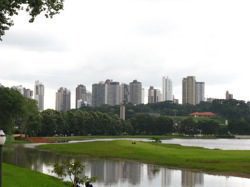Earthtalk is a weekly environmental column made available to our readers from the editors of E/The Environmental Magazine
 Dear EarthTalk: What is the “green cities” movement?
Dear EarthTalk: What is the “green cities” movement?
– John Moulton, Greenwich, CT
Best described as a loose association of cities focused on sustainability, the emerging “green cities movement” encompasses thousands of urban areas around the world all striving to lessen their environmental impacts by reducing waste, expanding recycling, lowering emissions, increasing housing density while expanding open space, and encouraging the development of sustainable local businesses.
Perhaps the archetypal green city is Curitiba, Brazil. When architect and urban planner Jamie Lerner became mayor in 1972, he quickly closed six blocks of the city’s central business district to cars, delighting residents and business owners alike. Today the pedestrian-free zone is three times larger and serves as the heart of the bustling metropolis. Lerner also put in place a high-tech bus system, greatly reducing traffic, energy usage and pollution; the move also encouraged density around transit hubs and thus preserved open space in other areas that would have likely turned into suburbia. Today the bus system still goes strong, and three-quarters of the city’s 2.2 million residents rely on it every day.
Another green cities leader is Rekyjavik, Iceland, where hydrogen-powered buses ply the streets and renewable energy sources—geothermal and hydropower—provide the city’s heat and electricity. London, Copenhagen, Sydney, Barcelona, Bogota and Bangkok, not to mention Sweden’s Malmo, Ecuador’s Bahía de Caráquez and Uganda’s Kampala, also score high for their green attributes and attitudes.
Green cities abound in North America, too. In 2005, Portland, Oregon became the first U.S. city to meet carbon dioxide reduction goals set forth in the landmark (if ill-fated) Kyoto Protocol, an international agreement forged to mitigate the threat of global warming. Seattle, Washington also committed to meeting Kyoto’s goals and has persuaded 590 other U.S. cities to do the same under the U.S. Mayors Climate Protection Agreement. And Vancouver, British Columbia draws 90 percent of its power from renewable sources while its metro area boasts some 200 parks and more than 18 miles of accessible waterfront.
San Francisco is a leader in green building, energy efficiency and alternative energy, and has been on the forefront of the battle to reduce plastic usage. Austin, Texas is fast becoming a world leader in solar equipment production and has made great strides in preserving open space. Chicago has invested hundreds of millions of dollars revitalizing its parks and neighborhoods, and has built some of America’s most eco-friendly downtown buildings. It is also working to provide affordable clean power to low-income families. Of course, many would argue that New York City—with its densely packed housing, reliance on mass transit and walking, and recent green policy moves by Mayor Bloomberg—may be the greenest of all.
While there is no formal green cities organization, per se, many groups have sprung up to help urban areas achieve their sustainability goals. GreenCities Events, for one, hosts conferences around the U.S. at which local experts, policymakers and business leaders share ideas for greening their region. And International Sustainable Solutions takes urban planners, developers and elected officials on tours so they can check out some of the world’s greenest cities to glean first-hand what works and what can be applied back home.
Contacts:
Mayors Climate Protection Center
GreenCities Events
International Sustainable Solutions
Image Credit: Astrodyum, courtesy Wikipedia
GOT AN ENVIRONMENTAL QUESTION?
- Send it to: EarthTalk, c/o E/The Environmental Magazine, P.O. Box 5098, Westport, CT 06881
- Submit it at: www.emagazine.com/earthtalk/thisweek/, or e-mail: earthtalk[at]emagazine.com.
- Read past columns at: www.emagazine.com/earthtalk/archives.php.
E – The Environmental Magazine


